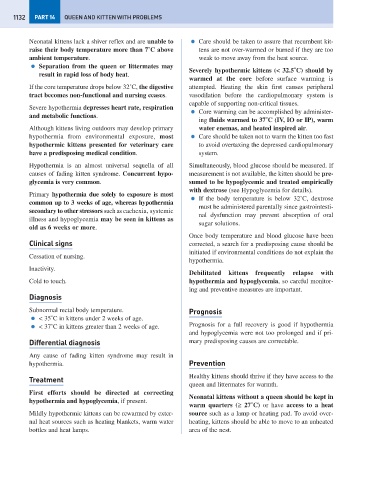Page 1140 - Problem-Based Feline Medicine
P. 1140
1132 PART 14 QUEEN AND KITTEN WITH PROBLEMS
Neonatal kittens lack a shiver reflex and are unable to ● Care should be taken to assure that recumbent kit-
raise their body temperature more than 7˚C above tens are not over-warmed or burned if they are too
ambient temperature. weak to move away from the heat source.
● Separation from the queen or littermates may
Severely hypothermic kittens (< 32.5˚C) should by
result in rapid loss of body heat.
warmed at the core before surface warming is
If the core temperature drops below 32˚C, the digestive attempted. Heating the skin first causes peripheral
tract becomes non-functional and nursing ceases. vasodilation before the cardiopulmonary system is
capable of supporting non-critical tissues.
Severe hypothermia depresses heart rate, respiration
● Core warming can be accomplished by administer-
and metabolic functions.
ing fluids warmed to 37˚C (IV, IO or IP), warm
Although kittens living outdoors may develop primary water enemas, and heated inspired air.
hypothermia from environmental exposure, most ● Care should be taken not to warm the kitten too fast
hypothermic kittens presented for veterinary care to avoid overtaxing the depressed cardiopulmonary
have a predisposing medical condition. system.
Hypothermia is an almost universal sequella of all Simultaneously, blood glucose should be measured. If
causes of fading kitten syndrome. Concurrent hypo- measurement is not available, the kitten should be pre-
glycemia is very common. sumed to be hypoglycemic and treated empirically
with dextrose (see Hypoglycemia for details).
Primary hypothermia due solely to exposure is most
● If the body temperature is below 32˚C, dextrose
common up to 3 weeks of age, whereas hypothermia
must be administered parentally since gastrointesti-
secondary to other stressors such as cachexia, systemic
nal dysfunction may prevent absorption of oral
illness and hypoglycemia may be seen in kittens as
sugar solutions.
old as 6 weeks or more.
Once body temperature and blood glucose have been
Clinical signs corrected, a search for a predisposing cause should be
initiated if environmental conditions do not explain the
Cessation of nursing.
hypothermia.
Inactivity.
Debilitated kittens frequently relapse with
Cold to touch. hypothermia and hypoglycemia, so careful monitor-
ing and preventive measures are important.
Diagnosis
Subnormal rectal body temperature. Prognosis
● < 35˚C in kittens under 2 weeks of age.
● < 37˚C in kittens greater than 2 weeks of age. Prognosis for a full recovery is good if hypothermia
and hypoglycemia were not too prolonged and if pri-
Differential diagnosis mary predisposing causes are correctable.
Any cause of fading kitten syndrome may result in
hypothermia. Prevention
Healthy kittens should thrive if they have access to the
Treatment
queen and littermates for warmth.
First efforts should be directed at correcting
Neonatal kittens without a queen should be kept in
hypothermia and hypoglycemia, if present.
warm quarters (≥ 27˚C) or have access to a heat
Mildly hypothermic kittens can be rewarmed by exter- source such as a lamp or heating pad. To avoid over-
nal heat sources such as heating blankets, warm water heating, kittens should be able to move to an unheated
bottles and heat lamps. area of the nest.

